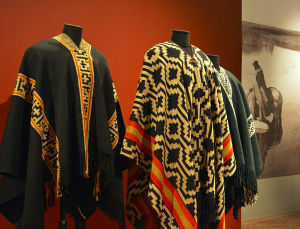Capítulo 2: En la Universidad
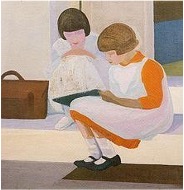 Petrona Viera (Uruguay) |
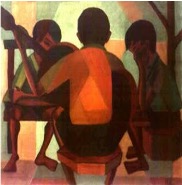 Olga Blinder (Paraguay) |
|---|
Sobre las artistas: These two important South American artists created portraits that represented the experiences of growing up through the eyes of children. Both artists were very involved in education in their own countries, promoting the arts, reading, and learning. In these paintings, we see daily life activities rather than landscapes.
Learning Objectives
At the end of this chapter, students will be able to perform the following tasks in Spanish:
● I can talk about the time of day
● I can talk about my classes and major
● I can discuss everyday activities
● I can ask and answer questions
● I can talk about likes and dislikes
Vocabulario
Classroom / Fields of study / Days of the week / Months of the year
Pronunciación
Linking
Mosaicos culturales
Influences of Indigenous Languages on the Spanish Language
Estructuras gramaticales
2.1 Telling time
2.2 Present tense of -AR verbs
2.3 Forming questions
2.4 Numbers 100 and higher
2.5 Express likes and dislikes
Escritura
Mis estudios
Cultura
País: Uruguay & Paraguay
Música: Tierra Adentro
Personalidad: Mario Benedetti
Lectura
¿Cómo seleccionar una carrera universitaria en Hispanoamérica?
Vocabulario: En la universidad
| Las clases (las materias)
la administración de empresas |
Classes
business administration archeology |
|---|
| Las especialidades (las Carreras Universitarias)
Administración de Empresas |
Majors
business administration |
|---|

| La clase y la universidad el/la compañero/a de clase el/la estudiante el/la profesor (a) el semestre el horario el curso, la materia la clase la especialidad (especialización) la carrera el examen la prueba el ensayo el informe la tarea el borrador la cartelera el escritorio el lápiz el libro el mapa el marcador la mesa la mochila el globo el papel la papelera la pizarra el pupitre la pluma; el bolígrafo; el lapicero la puerta el reloj la silla la ventana |
Class and University classmate student teacher semester schedule course class major degree; major test; exam test; quiz essay class report homework eraser bulletin board desk pencil book map marker table backpack globe paper wastebasket blackboard student desk pen door clock; watch chair window |
|---|
| En el campus
el auditorio |
auditorium |
|---|
| Los días de la semana
lunes
¿Qué día es hoy?
NOTE: to say ON + day use EL + day. Example: On Monday – – el lunes On Tuesdays – –los martes |
Days of the week
Monday
What day is today?
|
|---|
| Meses del año
enero Qué fecha es hoy |
Months
January |
|---|
ACTIVIDAD # 1
ACTIVIDAD # 2
Selecciona. Select the vocabulary word that does not belong to the group:
| 1. | curso | materia clase | globo |
|---|---|---|---|
| 2. | semestre | horario borrador | clases |
| 3. | ventana | carrera puerta | pizarra |
| 4. | tarea | pluma lapicero | bolígrafo |
| 5. | materia | carrera cartelera | especialidad |
| 6. | papel | prueba examen | ensayo |
| 7. | cartelera | papelera mapa | tarea |
| 8. | silla | mesa escritorio | semestre |
¡Inténtalo!
ACTIVIDAD # 3
Using the vocabulary, name the numbered items below.
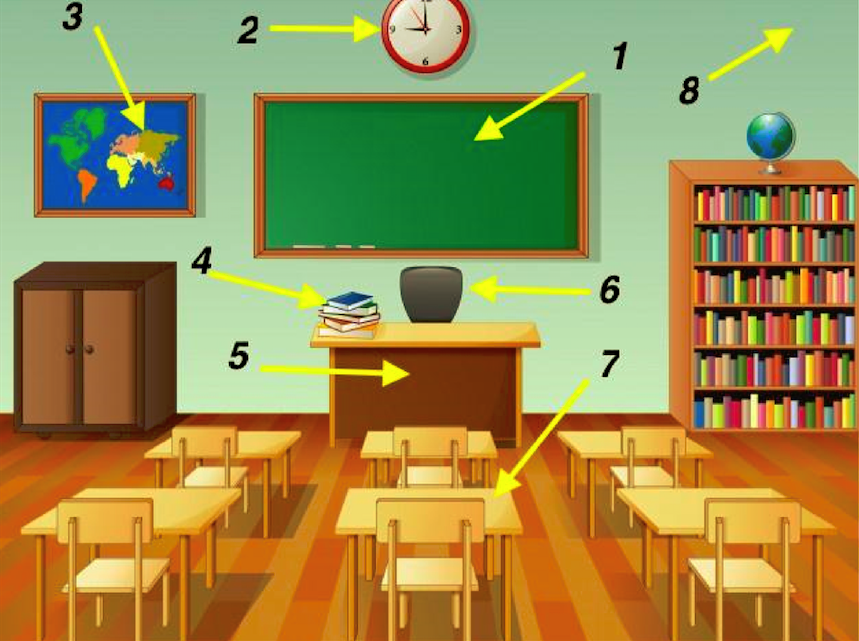
1. ___________________ 2._________________ 3.__________________
4. __________________ 5. _________________ 6. __________________
7. __________________ 8. __________________
ACTIVIDAD # 4
¿Qué clase es? Name the class associated with the subject matter.
Use the following structure: Es la clase de . . . . . . . .
- Sandra Cisneros, Hemingway
- Calculadora, geometría
- Picasso, Georgia O’keefe
- El océano Atlántico, Europa
- Freud, Jung
- Cristobal Colón, Abraham Lincoln
ACTIVIDAD # 5
¿Qué día es? Knowing that mañana means tomorrow and pasado mañana means the day after tomorrow, give the information following the example.
Ejemplo: Hoy es miércoles. Mañana es jueves y pasado mañana es viernes
- Hoy es sábado.
- Hoy es lunes.
- Hoy es jueves.
- Hoy es domingo.
ACTIVIDAD # 6
With a partner, take turns asking and responding to the following questions:
- ¿Qué clases tomas (do you take) los lunes? TOMO (I take). . . . . .
- ¿Cuántas (how many) clases tomas este semestre?
- ¿Cuál es tu (your) clase favorita? Mi clase favorita es. . .
- ¿Cuál es tu especialidad? Mi especialidad es. . .
ACTIVIDAD # 7
Preguntas personales. With a partner, take turns asking and responding to the following questions:
Estudiante A
- ¿Qué día es hoy? Y ¿mañana?
- ¿Eres estudiante de matemáticas?
- ¿Cuál es tu especialidad?
- ¿Qué hay en tu mochila?
- ¿Es la clase de español fácil o difícil?
Estudiante B
1. ¿El próximo (next) mes es abril? ¿En qué mes es Navidad?
2. ¿Tomas una clase de biología este semestre?
3. ¿Qué hay en la sala de clase?
4. ¿Qué lengua extranjera estudias? ESTUDIO ________
5. ¿Hay una cafetería en la universidad? ¿Hay un laboratorio?
Pronunciación
Linking
When words are combined to form phrases or sentences, they are linked together in pronunciation. In spoken Spanish, it is often difficult to hear where one word ends and another begins.
ACTIVIDAD # 1
Practice saying the following phrases or sentences as if they were one long word, pronounced without a pause.
Note: Y means and
- La profesora y el estudiante
- El inglés y el español
- La historia y la sicología
- La clase en la biblioteca
- No hay estudiantes hoy (today)
- Hay quince estudiantes en la clase
- ¿Qué hora es? (what time is it?)
Mosaicos culturales: Influences of Indigenous Languages in the Spanish Language
| The four significant languages that influenced the Spanish language are Mayan, Náhutl (Aztecs) in Mexico, the Quechua (Incas), and Aymara in Perú and Bolivia. Other relevant indigenous languages still spoken are Mapuche (Chile) and Guaraní (Paraguay). All languages have provided numerous terms for food and several common activities. Languages like English have adopted many terms that have origins in these languages, for instance:
|
|---|
Y ahora ustedes…
1. The following words are commonly used in Spanish, but can you guess the meaning in English?
| Words (palabras) | Native Language Originated | English Meaning |
| Aguacate | Náhuatl (Aztecs-Mex.) | |
| Cancha | Quechua (Incas- Perú/Bolivia) | |
| Cigarro | Mayan (Mexico) | |
| Guayaba | Arawak (Antilles) |
|---|
2. Do you know of any words in English that are borrowed from Indigenous Languages?
Check out this page to find out: Merriam-Webster
2.1 Gramática: Telling Time
¿Qué hora es? It is used to ask What time is it? Use the following word order to tell the time in Spanish.
| Es la (for one o’clock) / Son las (for all other hours) + hour + y (and; past) + minutes |
| 1:20: Es la una y veinte; 2:10: Son las dos y diez |
| Es la (for one o’clock) / Son las (for all other hours) + hour + menos (to; till) + minutes |
| 12:40: Es la una menos veinte; 2:50: Son las tres menos diez |
|---|
To tell time in Spanish, start with:
Son las (for all hours except one o´clock)
Es la (for the one o´clock hour)
To distinguish for AM or PM, use:
de la mañana
de la tarde
de la noche
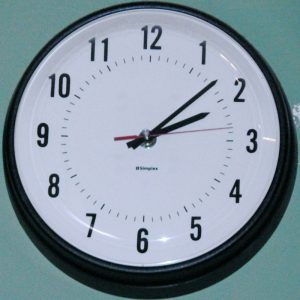 2:07
2:07
Son las dos y siete de la mañana.
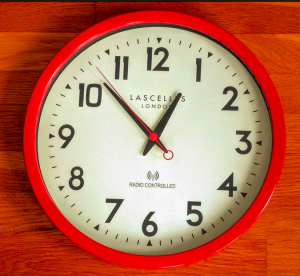
12:54
Es la una menos seis de la tarde.
Notes: In many Hispanic countries, printed schedules use the 24-hour clock.
- To indicate that an activity takes place at an undefined time of the day, use POR LA MAÑANA, POR LA TARDE, POR LA NOCHE.
- To express exactly, on the dot, sharp use EN PUNTO.
- At what time…….? ¿A qué hora. . . ?
¿A qué hora es la clase de español? A las diez de la mañana.
(at) What time is the Spanish class? At ten a.m.
ACTIVIDAD # 1
Listen as your instructor says a time of day. Find the clock face that corresponds to the time you heard and write the time in Spanish.

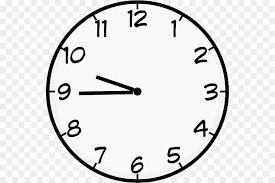

12:00 9:45 2:07
1._________________ 2. ____________________ 3. ___________________
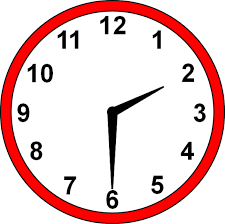
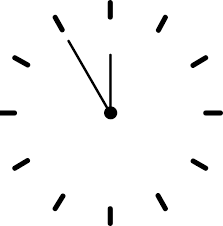
2:30 11:55
4. ___________________ 5. _____________________
ACTIVIDAD # 2
¿Qué hora es? Express the time in full sentences in Spanish.
- 6: 10 p.m.
- 4:30 a.m.
- 1:15 p.m.
- 9:50 on the dot
- 12: 55
ACTIVIDAD # 3
Situaciones. How might the following people greet each other according to the time of the day? With a classmate, create a short dialogue for each situation.
Ejemplo: María y Jorge, a las once de la noche.
Jorge: Buenas noches, María
María: ¡Hola! Jorge, ¿Cómo estás?
Jorge: Bien, ¿y tú?
María: ¡Muy bien!
- El profesor García y Rosa, a las diez de la mañana
- La Sra. Martínez y el Sr. Gómez, a las cinco de la tarde
- Tú y tu (your) profesora de español, en la clase de español
ACTIVIDAD # 4
2.2 Gramática: Present tense of -AR verbs
A. The present tense in Spanish may have various definitions in English.
For example: “Yo hablo” may be translated as:
I am speaking (progressive) I speak (present tense) I do speak (emphatic)
B. The present tense of –AR regular verbs is formed by dropping the infinitive ending (-AR) and adding the following endings according to the subject:
ESTUDIAR (to study)
| Singular | Plural | ||
| Yo | estudio | Nosotros (as) | estudiamos |
| Tú | estudias | Vosotros (as) | estudiáis |
|---|---|---|---|
| Él, Ella, Usted | estudia | Ellos, Ellas, Ustedes | estudian |
NOTE: To make a sentence negative, put “NO” in front of the conjugated verb.
I don’t speak Spanish = No hablo español
She doesn’t travel = Ella no viaja
The following is a list of common regular -AR verbs in Spanish:
| Ayudar a | to help | Mirar | to look at; to watch |
| Bailar | to dance | Montar | to ride |
| Buscar | to look for | Necesitar | to need |
|---|---|---|---|
| Caminar | to walk | Pagar | to pay for |
| Cocinar | to cook | Practicar | to practice |
| Comprar | to buy | Preguntar | to ask questions |
| Contestar | to answer | Regresar | to return |
| *Desear + verb | to desire | Terminar | to finish |
| Descansar |
to rest | Tocar | to touch/to play an instrument |
| Enseñar | to listen | Trabajar | to work |
| Hablar | to speak | Tomar | to take; to drink |
| Llamar | to call | Viajar | to travel |
| Llevar |
to carry; to take; to wear |
Visitar |
to visit |
Verb Chart. Complete the verb table.
| Tú | trabajas | |||||
| Hablar | Escuchar | Necesitar | Trabajar | Viajar | Llamar | |
| Yo | escucho | |||||
| Él, Ella, Usted (Ud.) |
llama | |||||
| Nosotros(as) | necesitamos | |||||
| Vosotros(as) | habláis | |||||
| Ellos, Ellas, Ustedes (Uds.) |
viajan |
Ejemplos:
- Yo deseo hablar español = I wish to speak Spanish.
- Mi hermana escucha música clásica = my sister listens to classical music.
- Nosotros visitamos el museo = We visit the museum.
ACTIVIDAD # 1
Oraciones. Gloria is explaining what everybody does on Saturday. Conjugate the verbs accordingly:
- Mi mamá / comprar comida:
- Yo / caminar en el parque:
- Mi papá / trabajar en el jardín los fines de semana :
- Mis hermanos (my siblings) / bailar:
- Mi abuela (my grandmother) / cocinar muy rico (good):
ACTIVIDAD # 2
Contestar. Respond to the following personal questions:
- ¿Tú trabajas o estudias?
- ¿Tú hablas portugués?
- ¿Tú miras televisión por la noche?
- ¿Tú llamas mucho por teléfono?
- ¿Tú practicas el español en tu casa?
ACTIVIDAD # 3 Write-Pair-Share
Situaciones. How would you express the following ideas in Spanish?
Use –AR ending verbs:
- Tell a friend that you need a hundred dollars.
- Tell your friend that your mom returns home at 6 pm.
- Say that you and your friends walk to class.
- Say that you work 40 hours a week.
- Tell the class that you visit Mexico often (frecuentemente).
ACTIVIDAD # 4
Seleccionar. Select the appropriate verb and write a complete sentence in the present tense according to the following images:
| HABLAR TRABAJAR BAILAR VIAJAR ESTUDIAR ESCUCHAR |
|---|
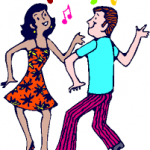


1. __________________ 2. ___________________ 3. ____________________
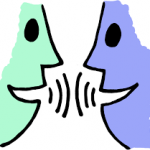
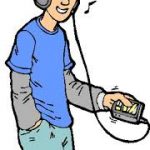

4.__________________ 5. __________________ 6.____________________
ACTIVIDAD # 5 Compañeros de clase
Paso 1. Read about two college students: Raquel and her friend Felipe.
Paso 2. After reading, complete the reading comprehension activities below.
Press play to listen to the pronunciation of the reading in the paragraph written below.

Hola amigos, me llamo Raquel Melgar. Estudio psicología en la Facultad de Humanidades de la Universidad de Madrid. Mis clases son muy temprano (early) los lunes y los miércoles. Yo camino a la universidad y llego a las ocho menos cuarto. Este semestre mis clases son arte, español, psicología y estadística. La clase de psicología es mi favorita. La clase de estadística es difícil, pero la profesora es muy buena. Por las tardes trabajo en una oficina de la universidad. |
|---|

Este es el amigo de Raquel. Se llama Ryan Smith. Estudia español en la universidad. Es norteamericano. Sus clases este semestre son literatura, matemáticas, historia, geografía y español. Muchas clases ¿verdad? Ryan está muy ocupado (is very busy) este semestre, pero es muy estudioso y saca buenas notas. Él practica español con Raquel todos los días. A las cinco de la tarde estudia en la biblioteca y después a las siete regresa a su piso (apartamento). |
|---|
¿Qué sabes de (what do you know about) Raquel? Completa:
- Las clases de Raquel son los lunes y
- Raquel toma clases.
- Su clase favorita es .
- Su clase difícil es
- Raquel trabaja en
¿Qué sabes de Ryan? Verdadero (V) o Falso (F). If false, give the correct answer.
- Ryan practica español con sus profesores
- Ryan toma cinco clases
- El apellido de Ryan es Smith
- Ryan estudia español en la universidad
- A las siete de la tarde Ryan estudia
- Ryan saca malas notas
ACTIVIDAD # 6
Tu agenda semanal. Complete your weekly agenda using what you learned
in lesson 2. Use complete phrases and TWO activities for each day.
Ejemplo: Lunes
TOMO dos clases A las diez de la mañana.
TRABAJO De (from) cinco a (to) ocho de la noche.
| Día de la semana | Actividades | Hora |
|---|---|---|
| Lunes | ||
| Martes | ||
| Miércoles | ||
| Jueves | ||
| Viernes | ||
| Sábado | ||
| Domingo |
Answer the following questions in complete sentences:
1. ¿Cuál es tu día favorito? ¿Por qué? (why)
2. ¿Cuál es tu día más ocupado?
ACTIVIDAD # 7 ¡Hablemos!
With a partner, take turns asking and responding in Spanish to the following questions:
Ejemplo:
E1: ¿Hablas inglés?
E2: Sí, hablo inglés (Sí, hablo un poco/ poquito)
No, no hablo inglés.
Estudiante A
1. ¿Trabajas?
2. ¿Hablas español?
3. ¿Tocas un instrumento musical?
4. ¿Compras libros en Amazon?
5. ¿Miras la tele por la noche (at night)?
Estudiante B
1. ¿Estudias español este (this) semestre?
2. ¿Escuchas música todos los días?
3. ¿Llegas tarde (late) a la clase de español?
4. En la clase de español, ¿Contestas en español o en inglés?
5. ¿Buscas palabras (words) en el diccionario?
2.3 Forming Questions
* To form a question in Spanish, two interrogative symbols are required: ¿?
* There are THREE (3) ways to ask questions in Spanish:
1. Yes / No questions. One way to form a question in Spanish is to raise your intonation at the end of the last word in the statement.
Example: Statement – Ella trabaja en el hospital.
Question – ¿Ella trabaja en el hospital? ⤴ or
¿Trabaja ella en el hospital? ⤴
2. Tag Questions. In Spanish questions can also be formed by adding the tag ¿no? (isn´t it? aren’t they?) or ¿cierto? / ¿verdad? (right?, is it?, are they? ) at the end of the statement.
Example: Statement – Ella trabaja en el hospital.
Question – Ella trabaja en el hospital, ¿no?
She works at the hospital, doesn´t she?
3. Interrogative Questions. To ask questions that inquire further information, use an interrogative word at the beginning of the question (make sure the interrogative word is accentuated).
Example: ¿Dónde trabaja ella? (Where does she work?)
| ¿Adónde? | To where / Where to? |
|---|---|
| ¿De dónde? | From where? |
| ¿Dónde? | Where? |
| ¿Cómo? | How? |
| ¿Cuál? ¿Cúales? | Which (one)? Which (ones)? (sing. / pl.) |
| ¿Cuánto? ¿Cuánta? |
How much? (masc. / fem.) |
| ¿Cuántos? ¿Cuántas? | How many? (masc. / fem.) |
| ¿Quién? ¿Quiénes? | Who? (sing. / pl.) |
| ¿A quién? | To whom? |
| ¿Con quién? | With whom? |
| ¿De quién? | Whose? Of whom? |
| *¿Por qué? | Why? |
| ¿Qué? | What? Which? |
* PORQUE (no accent, one word) means BECAUSE.
NOTA: ¿Qué vs. Cuál? + SER (to be) What is. . Which is. .
Both ¿Qué? and ¿Cuál? are equivalent in English to “What?” and “Which?”, but in Spanish, both words are not usually interchangeable.
ACTIVIDAD # 1
Cambiar. Change the following statements to yes/no questions: intonation and tag.
Ejemplo:
Statement Ellos son de España.
Yes/ no questions ¿Ellos son de España?⤴ ¿Son ellos de España?⤴
Tag questions Ellos son de España, ¿cierto?
- Uds. compran el libro.
- Él trabaja en un restaurante.
- Necesitamos estudiar más.
- Ella viaja a España.
- Tú escuchas música Hip-Hop.
ACTIVIDAD # 2
Preguntar. Which questions were asked that originated the following answers?
- __________________________________________
Sí, yo estudio por la noche. - __________________________________________
No, mis padres compran los libros en Amazon - ___________________________________________
No, nosotros no contestamos las preguntas en inglés. - ___________________________________________
Sí, Lucía regresa mañana de Puerto Rico. - ___________________________________________
Sí, yo deseo tomar un café con leche.
ACTIVIDAD # 3
Fill in the blank with the appropriate question word to complete
the questions. Use the following question words given below.
| Cómo Qué Cuántos/ Cuántas De dónde Cuál |
|---|
- ¿_______ pizarras hay en tu salón de clase?
- ¿_________está usted?
- ¿______tal?
4. ¿________es tu nombre?
5. ¿_______eres? – Soy de los Estados Unidos.
6. ¿______te llamas?
7. ¿______ años tienes?
8. ¿_____es tu día favorito?
¡Inténtalo!
ACTIVIDAD # 4
Escribir. Using the interrogative words, write the questions that initiated
the following answers.
- ______________________________
Me llamo Pedro López. - ______________________________
Ellos son de México - ______________________________
Hablo español y francés. - ______________________________
Escucho música rap. - _______________________________
Mi mamá trabaja en el hospital.
ACTIVIDAD # 5 ¡Hablemos!
With a partner, take turns asking and responding to the following questions:
Estudiante A
- ¿Qué día es hoy?
- ¿Dónde Trabajas ?
- ¿Cuántas clases tomas este semestre?
- ¿Cuál es tu clase más fácil? ¿Más difícil?
- ¿Qué días es tu clase de español?
- ¿Cuántos idiomas hablas?
- Tocas algún (any) instrumento musical?
Estudiante B
- ¿Qué día es mañana?
- ¿Qué clases tomas este semestre?
- ¿Cuál es tu clase favorita?
- ¿Estudias en la biblioteca? ¿Estudias mucho?
- ¿A qué hora llegas a casa los lunes?
- ¿Cuántos idiomas hablas?
- ¿Escuchas música todos los días?
2.4 Gramática: Numbers 101 and higher
| 101 | Ciento uno | 600 | Seiscientos | 10.000 | Diez mil |
|---|---|---|---|---|---|
| 200 | Doscientos | 700 | Setecientos | 20.000 | Veinte mil |
| 300 | Trescientos | 800 | Ochocientos | 100.000 | Cien mil |
| 400 | Cuatrocientos | 900 | Novecientos | 500.000 | Quinientos mil |
| 500 | Quinientos | 1.000 | Mil | 1.000.000 | Un millón |
A. Numbers after 100 will need the syllable “TO” added:
Example: 101 = ciento uno 110 = ciento diez
B. The numbers 200 through 999 will be plural and agree in gender with the nouns they modify.
Example: 201 = doscientos uno 340 houses = trescientas cuarenta casas
516 = quinientos dieciséis 862 books = ochocientos sesenta y dos libros
C. In Spanish, year numbers have a period (.) instead of a comma (,)
Example: 1.998 = Mil novecientos noventa y ocho
$10.000 = Diez mil dólares
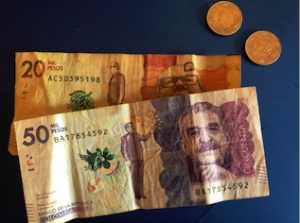
ACTIVIDAD # 1
Contestar. When did these historical events happen? Write down the years:
- 1.776 Independence of the USA______________________________________________.
- 1.810 Independence of Mexico______________________________________________.
- 1.492 = Christopher Columbus arrived in America______________________________________________.
- 1.969 = Man landed on the moon______________________________________________.
ACTIVIDAD # 2
ACTIVIDAD # 3
¡Hablemos! To ask how much a single item costs, say ¿CUÁNTO CUESTA…? For multiple items, use ¿CUÁNTO CUESTAN. . .? With a partner, practice asking and answering the prices of the following items:
Ejemplo:
Estudiante 1: ¿Cuánto cuesta la computadora?
Estudiante 2: Cuesta mil doscientos dólares ($ 1.200)
1.

2.

3.

4.

5. ¿Tu carro? (your car?) Mi carro cuesta $_______.
2.5 Gramática: GUSTAR (to express likes and dislikes)
- GUSTAR is different from other –AR verbs. To express what you like or dislike, use the expression (NO) ME GUSTA + el (la) + singular noun (and verbs), or (NO) ME GUSTAN + los (las) + plural noun.
- Never use the subject pronoun YO with GUSTA; you may use A MÍ (to me) for emphasis.
- The form of the verb GUSTAR in the present: GUSTA or GUSTAN does not depend on who does the liking, but depends on what is liked or what is pleasing.
- To ask someone what they like, use ¿Qué te gusta?
GUSTAR
| Me (to me)→ | ||
| Te (to you-informal) | gusta | *Singular noun: Me gusta la comida mexicana |
| Le (to him, to her, to you-formal) | **Infinitive (s): Me gusta hablar español | |
| Nos (to us) | ||
|---|---|---|
| Os (to ya’ll-Spain)
Les (to them, to you all-Lat. Am.) |
gustan |
*Plural noun: Me gustan las clases |
*If you use a noun, it must be accompanied by its definite article (el, la, los, or las).
**If you use a verb, leave it in the infinitive. You can list as many as you like!
Ejemplos:
- ¿Te gusta hablar español?
Sí, me gusta hablar español. - ¿Qué no te gusta?
No me gusta la comida rápida. - ¿A ustedes les gustan los gatos?
Sí, nos gustan los gatos. - ¿A ella le gusta escuchar música rock?
No, a ella le gusta escuchar música alternativa. - ¿Te gusta viajar?
Sí, me gusta viajar.
ACTIVIDAD # 1
ACTIVIDAD # 2
Paso 1: ¿Te gusta o no? Respond to the following prompts about what you like to do.
- ¿Te gusta la clase de español?
- ¿Te gusta trabajar?
- ¿Te gustan los perros?
- ¿Te gusta el café?
- ¿Te gustan las galletas de chocolate?
- ¿Te gusta escuchar música?
- ¿Te gusta mirar tus (your) redes sociales?
Paso 2: Hablemos. Use the questions from paso 1 to practice a conversation with your partner.
Use the following reactions to make the conversation more natural:
AGREEING: Me too/Me neither
- A mí también – Me too (use when agreeing with a positive statement).
Me gusta hablar español– ¡A mí también! - A mí tampoco – Me neither (use when agreeing with a negative statement).
No me gusta la leche — ¡A mí tampoco!
DISAGREEING: I do/I don´t
- A mí, no – I don´t (use when disagreeing with a positive statement).
Me gusta la leche – – ¡A mí, no! - A mí, sí. — I do (use when disagreeing with a negative statement).
No me gusta la leche.– ¡A mí, sí!
ACTIVIDAD # 3 ¡Hablemos!
Find someone who… walk around the class and find someone who likes or doesn´t like the following activities or things.
Note: the verb ENCANTAR is used to express when you LOVE something or LOVE TO DO something.
| Examples | Nombre | Nombre | |
|---|---|---|---|
| Le gusta hablar español | Le encanta jugar videojuegos | ||
| Le gusta nadar | Le gusta estudiar | ||
| No le gusta manejar (to drive) |
No le gusta Instagram | ||
| No le gusta escuchar hip-hop | No le gustan los vegetales | ||
| Le gustan las películas románticas | Le gusta la tarea |
ACTIVIDAD # 4 ¡Hablemos!
With a partner, take turns asking and responding the following questions:
1. ¿Qué tipo (what type) de música te gusta escuchar?
2.¿Te gusta estudiar? ¿Por qué?
3. ¿Qué te gusta hacer (to do) los fines de semana?
4.¿Te gusta tu trabajo? (your work)
5.¿Qué te gusta de tu media naranja (better half) (esposo (a), novio (a) )?
6.¿Te gusta viajar?
7.¿Qué NO te gusta hacer (to do)?
8.¿Te gusta bailar?
Escritura: Mis estudios
A. Plan de estudios
Below are some course offerings at the College of Science and Humanities at Arizona State University (ASU). Use them to answer the questions below in complete phrases:
| Historia del Arte II Literatura Española Moderna Anatomía Humana Historia de la fotografía Sexualidad humana y género Sociedad y sustentabilidad Producción, gente y ambiente Diseño 3-D Salud urbana y ambiental Español 313 |
|---|
Escribe DOS clases de ASU que te gustan
1.
2.
Escribe DOS clases de ASU que NO te gustan y ¿por qué?
1.
2.
¿Qué clases debe tomar un estudiante de sustentabilidad? (mention 2)
¿Qué clases debe tomar un estudiante de arte? (mention 2)
B. ¿Qué clases tomas tú? List the course you are taking this semester. Include days, AT WHAT times, and the name of the professors. Follow the example.
Ejemplo: Tomo matemáticas los lunes, miércoles y viernes A las ocho de la mañana Mi profesor se llama Señor Smith.
Clase(s) Días Hora Profesor (a)
Cultura: Uruguay & Paraguay
 |
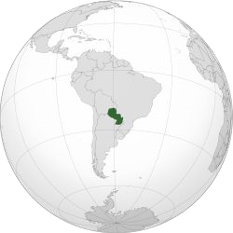 |
|---|---|
| URUGUAY
Capital: Montevideo Interesting facts: |
PARAGUAY
Capital: Asunción Interesting facts: |
Música: Tierra Adentro
Tierra Adentro es un grupo musical de Paraguay. Su música es un homenaje al folklore paraguayo.
| Canción: Paraguay
|
¡Paraguay!
¡En el corazón del Sur! (¡Paraguay!) Oh-oh, ¡Tierra Adentro! El alma de mi pueblo tiene magia (tiene magia) Tiene magia y en el corazón se siente Se siente un corazón valiente La fiesta de mi pueblo tiene magia (tiene magia) En el corazón del Sur (¡Paraguay!) La fiesta de mi pueblo tiene magia En el corazón del Sur (¡Paraguay!)… |
|---|
Personalidad: Mario Benedetti
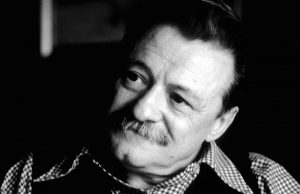
Press play to listen to the pronunciation of the reading in the paragraph written below.
Mario Benedetti es uno de los escritores más famosos y prolíficos de Uruguay y de América Latina. Es originalmente de Paso de Los Toros, Uruguay pero pasó (spent) muchos años fuera (away) de su país (country).
Su literatura es muy extensa e incluye la escritura periodística (journalism), poesía, novela y cuento (short stories). Su colección de poemas presenta diferentes temas como el amor y la política y habla de la vida y la sociedad. Su estilo combina pasión, determinación y compromiso (commitment) por su país. Benedetti abandonó (left) su natal Uruguay en 1973 para vivir en el exilio en Argentina y en España. Sus más de ochenta obras literarias (literary works) son traducidas (translated) a más de veinte idiomas.
“Perfection is a polished collection of errors.”
Mario Benedetti
Preguntas de comprensión. After reading the short biography of Mario Benedetti, answer the following questions.
- ¿Qué tipo de literatura escribe Mario Benedetti?
- ¿En qué países vivió (lived) Mario Benedetti?
- ¿En qué año sale Mario Benedetti de Uruguay?
- ¿Cuáles son unos temas (themes) de su literatura?
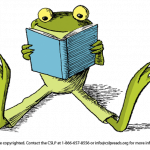 Lectura: ¿Cómo seleccionar una carrera universitaria en Hispano América?
Lectura: ¿Cómo seleccionar una carrera universitaria en Hispano América?
Paso 1. Read the following paragraph about how you choose a major in Spain and Latin America.
Press play to listen to the pronunciation of the reading in the paragraph written below.
En muchos países de habla hispana el gobierno ofrece una educación subsidiada* en las universidades públicas. Entonces a veces la matrícula (“tuition”) es casi gratis (“almost free”). La mayoría de los estudiantes en España y en Latinoamérica seleccionan la especialidad a los dieciocho años, cuando terminan la escuela secundaria o “bachillerato”. En muchos países como Perú, Bolivia y México, los estudiantes de último (“last”) año de bachillerato toman clases en un área específica, por ejemplo las artes o las ciencias. En español se usa la palabra “colegio” para designar la escuela (high school).
Después, los estudiantes seleccionan su especialidad o “carrera” (“major”) antes de entrar en la universidad. En muchos países como España o Colombia, los estudiantes necesitan tomar un examen de admisión y también un examen o “prueba de aptitud” (skills test like the SAT).
Cuando terminan la universidad los estudiantes reciben un título (“degree”) que se llama “Licenciatura” o “Ingeniería” y es equivalente a cuatro o seis años de estudio. Las carreras de Medicina o Leyes (“Law school”) toman de cinco a seis años.
* subsidized (it means that the state pays for most of the tuition)
Paso 2. Comprensión. Based on the reading, indicate if the following statements are true (VERDADERO) or false (FALSO). If false, write the correct information.
- Los estudiantes en Hispanoamérica y España seleccionan su especialidad a los quince años. ____
- “Bachillerato” es similar a escuela secundaria. ____
- En muchos países de Hispanoamérica los estudiantes seleccionan una especialidad antes de ir a la universidad. ____
- Muchos estudiantes necesitan tomar un examen de admisión para entrar a la universidad. ____
- Las carreras en Hispanoamérica y España son de más de seis años. ____
- Un ejemplo de “título universitario” es el “Bachillerato”. ____
- “Colegio” es similar a “Universidad”. ____


